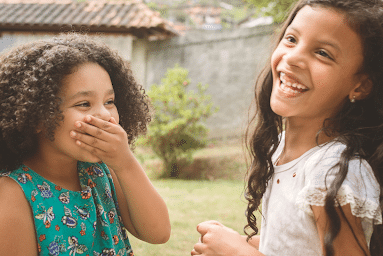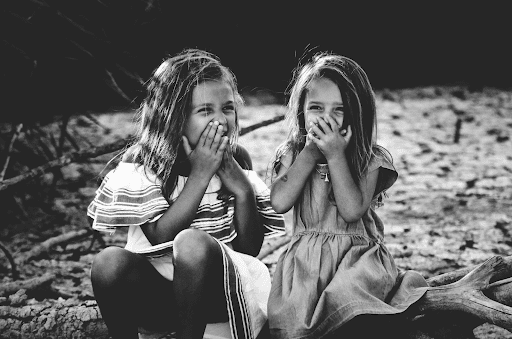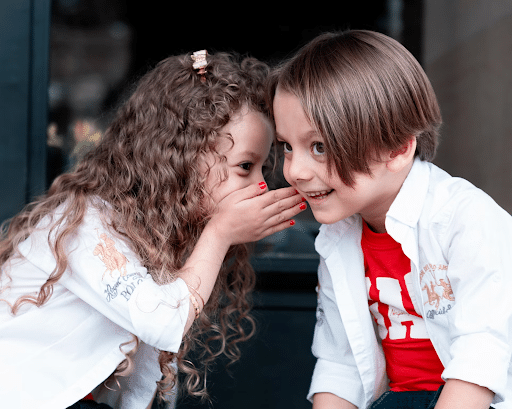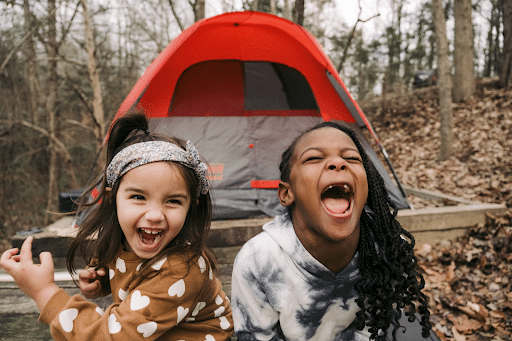Imagine being a young girl, carefree and full of laughter, only to be suddenly embarrassed by an uncontrollable and complete release of urine. This is the reality for kids suffering from giggle incontinence—a peculiar and often misunderstood condition that perplexes both patients and clinicians.
As a pelvic floor therapist, understanding giggle incontinence will help you to provide more effective support and treatment to kids struggling with this burdensome issue. This blog post delves into the symptoms, possible causes, distinguishing features, and current management and treatment strategies for this unique urinary disorder affecting many young girls.

What Is Giggle Incontinence?
Giggle incontinence is a condition characterized by the involuntary release of urine during or immediately after laughter. Unlike other forms of incontinence, giggle incontinence presents with complete voiding of the bladder rather than minor leaks or wet underwear.
This condition primarily affects prepubescent girls and is typically outgrown over time. Even though it’s commonly outgrown, this does not discount the dreadful experiences that these kids have to deal with psychologically and socially. By having a solid understanding of this condition, you will be able to clearly communicate with these girls and their families to provide support.
Symptoms And Identification
The hallmark symptom of giggle incontinence is complete bladder emptying triggered by laughter. Girls with this condition usually maintain normal bladder function when not laughing, differentiating it from other types of incontinence when leakage can occur at various times. Key points to look for include:
- Complete Bladder Emptying: During episodes of laughter, these girls do not just experience leaks but full bladder voiding.
- Prepubescent Onset: The condition predominantly affects prepubescent girls, typically resolving as they approach puberty.

Differentiating Giggle Incontinence From Stress Incontinence
You can distinguish giggle incontinence from stress incontinence, even though both involve involuntary urine release. The primary difference lies in the extent of voiding:
- Giggle Incontinence: Complete bladder emptying occurs exclusively during or after laughter.
- Stress Incontinence: Partial leakage happens due to various stressors like coughing, sneezing, or physical exertion, but not exclusively related to laughing.
However, kids with poor coordination or weakness of the pelvic floor can present with both types of urinary incontinence. Make sure you educate your patients and their parents on the differences, as this will help to quell their fears and concerns and to keep them committed to their treatment inventions.
Causes Of Giggle Incontinence
The exact etiology of giggle incontinence remains unclear, but some theories suggest it involves the central nervous system (CNS). Research indicates a potential imbalance in cholinergic and monoaminergic receptors within the CNS. This neurotransmitter imbalance might disrupt normal bladder control during laughter, causing complete urinary voiding.
- Cholinergic System: Involves neurotransmitters like acetylcholine, which play a critical role in muscle contraction, including the detrusor muscle of the bladder.
- Monoaminergic System: Involves neurotransmitters like serotonin and norepinephrine, which are crucial for mood regulation and also impact bladder control.
Research indicates a possible link between narcolepsy and giggle incontinence, as laughter or emotion can influence fluctuations in muscle tone. This relationship hints at a broader neurological basis for giggle incontinence, reinforcing the theory of central mediation.

Management And Treatment
Urodynamic diagnosis of giggle incontinence is difficult because the bladder response often is induced by unexpected or uncontrolled bouts of laughter. Yet urodynamic studies do demonstrate a lack of pelvic floor activation during laughing episodes.
You will find that currently, there is no standardized treatment protocol for giggle incontinence. However, you can use several effective strategies to manage and potentially reduce episodes for your patients that may include some combination of the following:
- Pelvic Floor Training
- Standard Urotherapy
- Increased Voiding Frequencies
- Protective Padding
- Dietary Modifications
- Addressing Constipation
- Biofeedback and Medications
Medication can be used to help reduce giggle incontinence episodes. Research shows that independently, biofeedback therapy and medication have similar success rates in the first, third, and sixth months of treatment. However, biofeedback therapy has been found to be more effective than medication when the treatment period is long term.

As a pelvic floor therapist, understanding the nuances of giggle incontinence can enhance your ability to support and manage affected patients. Continued research and communication within the medical community are essential for developing more effective treatment protocols.
In the meantime, you can practice a multidisciplinary approach to include pelvic floor training, standard urotherapy, dietary modifications, and behavioral strategies that can provide significant support for young girls dealing with giggle incontinence. By staying informed and proactive, you can better serve your patients and contribute to the evolving understanding of this condition.
To learn more about treatment of giggle incontinence and multiple other urinary incontinence issues, sign up for my Peds Level 1 course today!
References:
Onur Telli, Hamidi N, Aytaç Kayis, Evren Süer, Tarkan Soygür, Berk Burgu. Can the success of structured therapy for giggle incontinence be predicted? 2016;42(2):334-338. doi:https://doi.org/10.1590/s1677-5538.ibju.2014.0560
Ahmet Haciislamoglu, Murat Şakir Ekşi, Deniz Noyan Özlü, et al. Evaluation of the efficacies of methylphenidate and biofeedback treatments in giggle incontinence: One-year follow-up study. 2021;17(5):646.e1-646.e5. doi:https://doi.org/10.1016/j.jpurol.2021.07.015
Ann-Kristine Mandoe Svendsen, Konstantinos Kamperis, Soeren Hagstroem, Kristina Nauheimer Thorsteinsson, Mads Arvad, Borch L. The effect of methylphenidate for giggle incontinence in children. Neurourology and Urodynamics. 2023;42(7):1470-1475. doi:https://doi.org/10.1002/nau.25232
